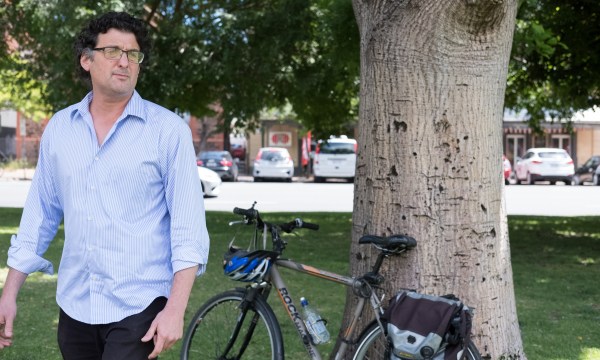Lofty, strategic goals to become an entirely carbon neutral city play out in surprising, small, and delightful ways in the daily lives of city residents.
Living green in the CBD
“The City of Adelaide aspires to be the world’s first carbon neutral city,” states the Council’s front page for sustainability.
CityMag is telling stories that chronicle Adelaide’s efforts to become a more sustainable city in partnership with the City of Adelaide.
It’s a lofty goal, and it raises questions. Alongside the obvious queries about exactly what can be done to turn a city and its cluster of high emissions cars and humans into a more sustainable prospect, there’s also the matter of how a green city affects those who live within it.
We spent a lunch break on Light Square with inner city resident, Zafi Bachar, to better understand the way in which sustainability-focused city-dwellers can and do live.

Given that Zafi works in the environment sector, it makes sense to us that he and his family make a concerted effort to live sustainably – though he would not entirely agree that his lifestyle is a sustainable one.
“It’s a matter of degrees. I wouldn’t say that I live sustainably. I live more sustainably than some other people, and less sustainably than some, so it’s not a yes or no, it’s a gradient,” Zafi says.
“The best sustainable thing you could do would obviously be to die… that would be incredibly sustainable,” laughs Zafi. “But, if you still want to be alive, then it’s all gradations, I suppose.”
But, as every one of us who has landed on this page has, Zafi obviously accepts that his existence on earth is going to continue, and so makes the best decisions he can to minimise the footprint he’ll leave behind.
Living in the Christie Walk eco village on Sturt Street is one such decision, and choosing to cycle around the city in place of driving and using public transport is another.
“Commuting is important because that happens most days. It adds up,” Zafi says. “If your work is centrally located and you live in the CBD, then the commute part of it becomes very easy to do sustainably. Adelaide is flat, you can ride even if you’re not fit.”
And, while city drivers are slowly coming around to the idea of sharing the road peacefully, the introduction of safer and more convenient cycling infrastructure is also a big part of making green commute options like cycling more accessible.
One such part of Carbon Neutral Adelaide’s (the slice of State Government and Adelaide City Council put to task on Adelaide becoming the world’s first carbon neutral city) action plan for 2016-2021 is to continue to build a comprehensive and integrated network of bicycle ways that connect Adelaide, North Adelaide and surrounding suburbs.
“There is more and more good bike infrastructure,” says Zafi. “Frome Road bike way is fantastic. I’m hugely appreciative of that.”
For Zafi and his family, their car, which he says is a 33 year old “re-use sort of job” is almost exclusively a weekend thing.
“I’d say typically twice a week we’d use the car,” he says, “but a lot of the time if we’re heading to the inner suburbs I still might cycle with my daughter and with my wife. And that part of it, it definitely helps to live in the city.”
Raising a family in the city is not often looked upon by Australian families as an ideal. But, Zafi says it’s all about the trade off, and it’s also not as expensive as many would expect.
“If you buy very small, then lots of people can afford to live in the city. It costs just as much as a house would cost a couple of suburbs out,” he says.
“Australians like to have a lot of space when they raise kids. And you sacrifice, or there is a perceived sacrifice when you live somewhere smaller.
“I know that it’s great to have a backyard for some things – I have friends [who live in the suburbs] who have a trampoline and 16 pets and sometimes swimming pools. [Zafi’s daughter] can visit them and enjoy those benefits, but at home we have other benefits. We can wake up on Saturday and roll into the Central Market, and we think that’s the best thing in the world. It’s not everyone’s priority. It’s a trade off, but it’s one that has worked for us.”
For those – like Zafi and his family – living within the borders of the Parklands, our city is quite literally very green, but they also feel it going through a process of metaphorical greening, which includes adapting to climate change, reducing carbon emissions, using resources wisely, and working with natural ecological systems.
“It’s a greening city,” says Zafi. “It’s trying to be greener, and I know that the Adelaide City Council has a greening city policy that it’s actively promoting.
“They’re probably already doing as much as a council can be expected to do. But, there’s always something more that you can do.”
And what’s good here is that people seem willing to learn about that little bit more they can do.







